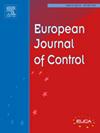Adaptive impedance control in master-slave robotic systems: Real-time estimation with update of reference impedance coefficients
IF 2.6
3区 计算机科学
Q2 AUTOMATION & CONTROL SYSTEMS
引用次数: 0
Abstract
This research addresses the challenge of effective human-robot interaction in master-slave robotic systems, particularly for applications like manufacturing and healthcare. A method is proposed for transferring desired impedance from a human operator to a slave robot. A three-term model estimates the interactive force/torque between the human hand and the master robot, with adaptive rules for updating stiffness and damping coefficients in real-time to provide accurate and responsive haptic feedback. These updated coefficients dynamically adjust the reference impedance model used to control the slave robot. This architecture, incorporating robust control techniques and estimators, ensures stability and transparency, enabling the master-side user to perceive conditions faced by the slave robot (e.g., obstacles). The slave robot responds according to the user's desired impedance, providing a seamless and intuitive interaction. Input-to-state stability analysis demonstrates robustness to disturbances and uncertainties. The proposed approach in this paper allows replicating the user impedance of the master robot to the slave robot, with the input-to-state stability of the entire closed-loop system analyzed in the presence of the proposed three-term model. The comparison of the root mean square (RMS) error measure for the tracking position and the tracking force/torque when the slave robot encounters an obstacle shows the favorable performance of the proposed approach compared to the impedance reference model approaches with fixed stiffness and damping coefficients and traditional position control approaches. Numerical simulations and experimental implementation validate the efficiency and accuracy of the proposed approach.
主从机器人系统中的自适应阻抗控制:参考阻抗系数的实时估计
本研究解决了主从机器人系统中有效人机交互的挑战,特别是在制造业和医疗保健等应用中。提出了一种将所需阻抗从人类操作者传递给从机器人的方法。一个三项模型估计人手与主机器人之间的交互力/扭矩,并具有实时更新刚度和阻尼系数的自适应规则,以提供准确和响应的触觉反馈。这些更新的系数动态调整用于控制从机器人的参考阻抗模型。该体系结构结合了鲁棒控制技术和估计器,确保了稳定性和透明度,使主端用户能够感知从端机器人面临的条件(例如,障碍物)。从机器人根据用户期望的阻抗做出响应,提供无缝和直观的交互。输入-状态稳定性分析证明了对干扰和不确定性的鲁棒性。本文提出的方法允许将主机器人的用户阻抗复制到从机器人,并在提出的三项模型的存在下分析了整个闭环系统的输入到状态稳定性。通过对从机器人遇到障碍物时跟踪位置和跟踪力/力矩的均方根误差测量结果的比较,表明该方法与固定刚度和阻尼系数的阻抗参考模型方法和传统的位置控制方法相比具有良好的性能。数值仿真和实验验证了该方法的有效性和准确性。
本文章由计算机程序翻译,如有差异,请以英文原文为准。
求助全文
约1分钟内获得全文
求助全文
来源期刊

European Journal of Control
工程技术-自动化与控制系统
CiteScore
5.80
自引率
5.90%
发文量
131
审稿时长
1 months
期刊介绍:
The European Control Association (EUCA) has among its objectives to promote the development of the discipline. Apart from the European Control Conferences, the European Journal of Control is the Association''s main channel for the dissemination of important contributions in the field.
The aim of the Journal is to publish high quality papers on the theory and practice of control and systems engineering.
The scope of the Journal will be wide and cover all aspects of the discipline including methodologies, techniques and applications.
Research in control and systems engineering is necessary to develop new concepts and tools which enhance our understanding and improve our ability to design and implement high performance control systems. Submitted papers should stress the practical motivations and relevance of their results.
The design and implementation of a successful control system requires the use of a range of techniques:
Modelling
Robustness Analysis
Identification
Optimization
Control Law Design
Numerical analysis
Fault Detection, and so on.
 求助内容:
求助内容: 应助结果提醒方式:
应助结果提醒方式:


